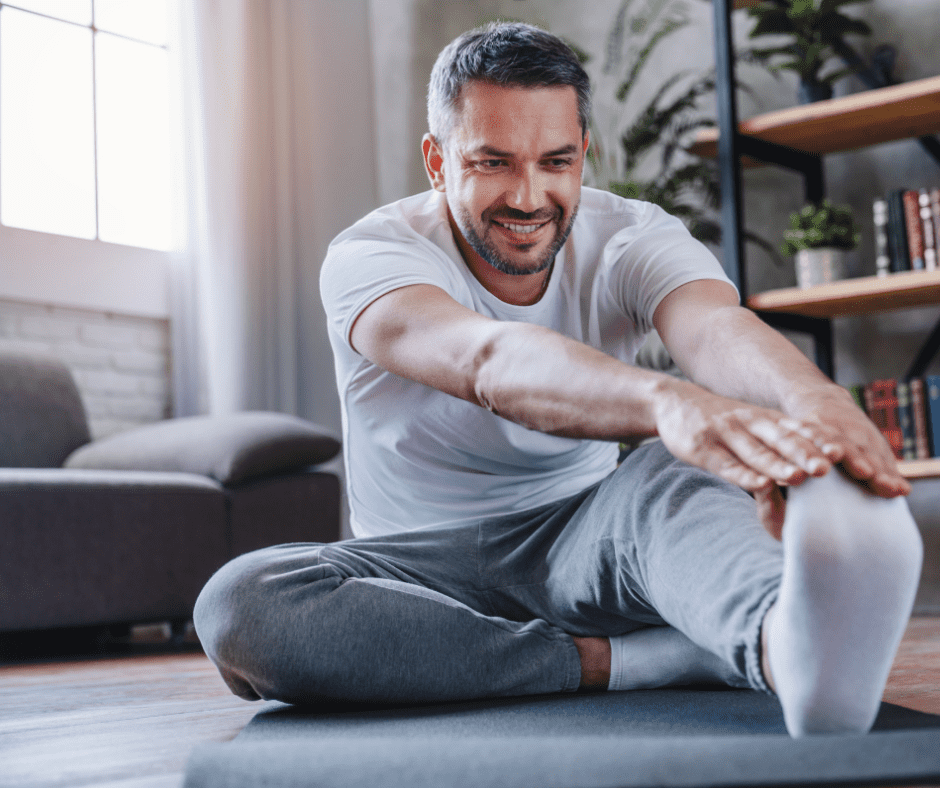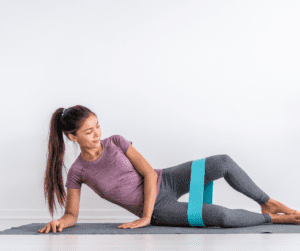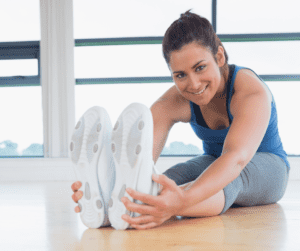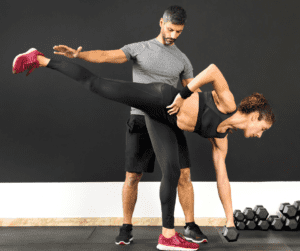Do you battle with tight hamstrings?
Hamstring problems can be the worst!
However, if treated correctly; followed by finding the root of the problem; you can give them a big fat kiss goodbye.
Hamstring problems do tend to need treatment as there are numerous reasons as to why they may be an issue… so getting to the bottom of it is a must.
Let’s look at the most common causes of tight hamstrings, how to combat those potential causes, how to prevent tight hamstrings, and what strength training exercises will help.

What Causes Tight Hamstrings?
There are a couple of key pointers to tight hamstrings and cycling is actually one of the most common causes.
This is because in our daily lives we sit a lot… There’s no doubt about it. When you cycle, your body is put into a forward flex position. So the actual act of cycling and closing up the joint angle between the femur, or the leg and your torso means that you get quite tight hip flexors from just sitting normally when you’re at your desk or watching TV, etc…
Riding a bicycle contributes to that and when you get so tight in your hip flexors you can get a slight pelvic tilt and when you get that pelvic tilt it effectively creates a situation where you have these “short tight hamstrings”.
It’s not actually that they’re that short and tight. It’s that they’ve been pulled to a position they’re not supposed to be in because you have got this potential pelvic tilt.

So, we know that tight hamstrings can be the result of a poor posture which causes a forward pelvic tilt, which puts your hamstrings in a lengthened and weakened position, even though they feel tight.
Another reason why your hamstrings could be tight is due to genetics, some people are naturally more limited in their hamstring flexibility and, as such, may be predisposed to tighter ones.
Poor glute activation could also lead to hip instability, which will result in tight hamstrings too.
Sports that require repetitive sprints or sudden direction changes can also cause tight hamstrings.
Now that we know what could be the cause of your tight hamstrings, let’s have a look at how to combat them…
How To Release Tight Hamstrings
The way to deal with tight hamstrings is to strengthen them so that they can help to pull your pelvis back into position and also stretch those hip flexors.
Tight hip flexors manifest in a couple of ways.
They manifest in hamstring problems, glute problems, and ITB problems and I guess it depends on each individual exactly where the problem is.
If you are running a lot of hills, especially if you’re running quite a bit off-road or steep climbs… you tend to lean forward quite a lot, which causes your lower back to tighten up, which again can lead to transferring of tightness into your hamstrings.
So to release your tight hamstrings you need to strengthen them as well as your lower back, you need to stretch your hip flexors and if you are running uphill often then you need to make sure you’ve got a really strong core and that will help to get that range of motion feeling a lot better.
Is There a Trick To Releasing Your Hamstrings?
Is there such a thing as a trick to sort out a hamstring, or should you resort to seeking medical attention….
Don’t let your hamstring turn into a chronic injury.
If you manage to sort out your tight hamstrings quickly then it won’t turn into a chronic injury and it won’t take as long to heal.
Purely resting very seldom sorts out the problem. Massaging with a tennis ball is going to give you a bit of a mild fascia release and loosen up the hamstring a little bit… But it’s not going to get into that deep tissue, massaging, or needling is probably required.
For a niggling chronic hamstring injury, there’s no way that just one physio session is going to sort it out. It’s probably going to take 3-5 physio sessions.
Between that, you might be allowed to do some cycling, maybe aqua jogging, or low impact exercise that does not elicit pain…
Chronic Hamstring Injury – You Need To Do Strength Training

If you don’t do strength training… as soon as your hamstrings get put under some pressure then you’re going to have another problem.
You need to work out where the imbalance is (Your physio can help with that) and how to deal with your imbalance… the main thing you need to find out is if it’s a strength issue or a flexibility issue.
How To Prevent Getting Tight Hamstrings?
- Strengthening Your Leg Muscles
You have to make your hamstrings stronger. You also need to improve the strength and activity of the muscles which support your hamstring.
- Move Your Body Throughout The Day
Even if your job requires you to sit at a desk all day, try to take regular breaks to prevent your muscles from tightening up.
- Eat a Healthy Diet
If you overwork your hamstrings, your recovery requires more than just ice and rest. You should incorporate vital nutritional elements, such as protein and carbohydrates to aid in your recovery.

Hamstrings Stretches
- Common Hamstring Stretch
Sit on the floor with both of your legs out straight in front of you.
Reach your arms towards your toes and bend at your waist while trying to keep your legs straight.
Hold for 15 seconds, release, and do 3x reps.
- Lying Hamstring Stretch
Lie down with your back flat on the ground and your legs out in front of you.

Right leg stretch: Hold the back of your right knee with both hands, pull the leg up toward your chest, and slowly straighten the knee until you feel it stretching. Hold for 15 seconds.
Left leg stretch: Hold the back of your left knee with both hands, pull the leg up toward your chest, and slowly straighten the knee until you feel it stretching. Hold for 15 seconds.
- Standing Hamstring Stretch
Stand upright with your spine in a neutral position.
Place your right leg in front of you with your heel on the ground and your foot flexed.
Have a gentle bend in your left knee.
Gently lean forward and place your hands on your right leg, which should be straight.
Keep a neutral spine.
Hold for 15 seconds and repeat x3 reps, then switch sides.
Hamstrings Strength Exercises
- Eccentric Bridge
- Start with double leg bridges (up on two legs, down on one leg).
- Progress to: up on two legs, down on the affected side.
- Lastly progress: upon the affected leg and down on the affected leg.
Best repetitions are 3×12 reps, to begin with, followed by progressions over time to 3×15-20reps.
- Single-Leg Romanian Deadlift

- Stand balancing on your right leg and hold a dumbbell with your left hand in front of your thigh.
- Sit your hips back as if you were being pulled by a rope attached to your waist., and allow your right knee to bend slightly. Your left leg should be straight (it’s OK if there’s a slight bend in the knee) and in line with your body throughout the rep.
- Keeping your back flat, continue to bend at the waist until the dumbbell is at about mid-shin height.
- Drive through your heel and push your hips forward to stand up to the starting position.
- Lateral Walks with Band Around Forefoot
- Start by placing a resistance band around the balls of both feet and take a hip-width stance.
- Slightly bend your knees and hinge forward at the hips until your torso is about 30 to 45 degrees. Begin walking like a crab and taking side steps that are a few inches wide while keeping your feet forward.
Here at Coach Parry, we’re massive advocates of strength training. We’ve put together this free strength training plan for runners that you can do once a week, at home and with no expensive equipment needed. You can access it by clicking here.
Don’t let tight hamstrings get in your way…
If you feel pain or have other concerns, don’t hesitate to make an appointment with your doctor.




Comments are closed.